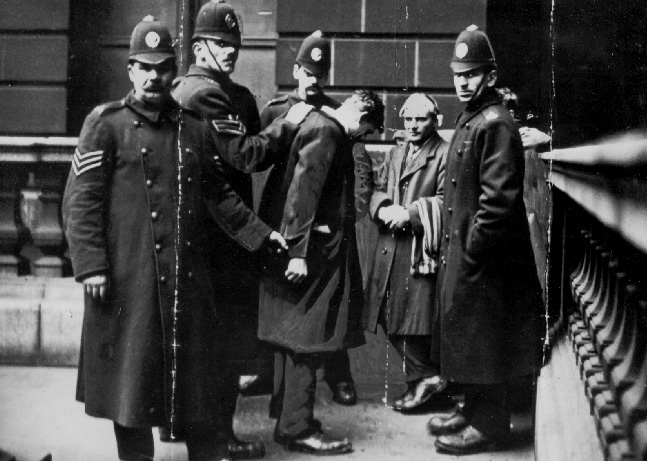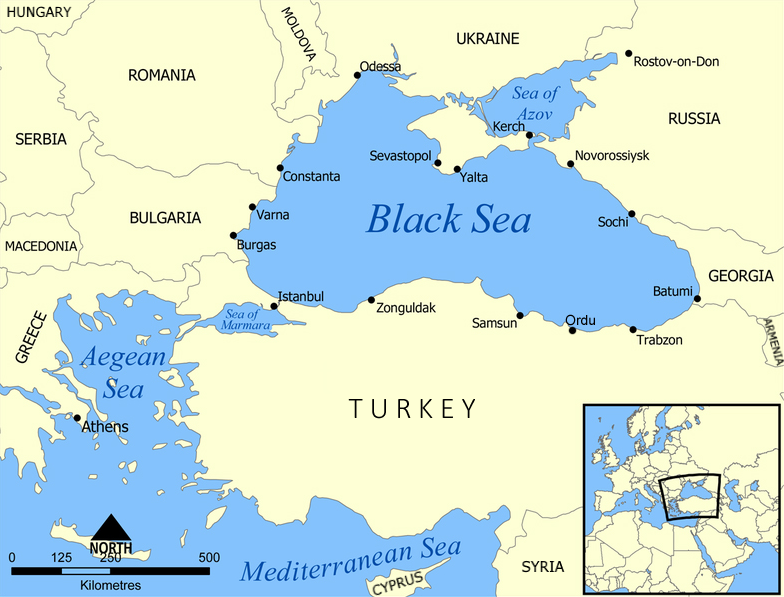|
Azov-Black Sea Flotilla
The Azov-Black Sea FlotillaЦДАВОВУ. — Ф. 2. — Оп. 1. — Спр. 136. — Арк. 6 was a formation of the Makhnovist fleet, the main area of which was the Sea of Azov. History In the spring of 1919, the Makhnovists occupied Berdyansk, where they began to form a navy from adapted civilian ships, on which weapons were installed. In late April - early May 1919, several sailors received a three-inch (76-mm) cannon and appeared in front of the Berdyansk Revolutionary Committee with the initiative to install it on a boat that could be used to patrol the waters of the Azov Sea. But the boat was in very poor condition. Engineers called for its examination and confirmed their suspicions that the cannon should not be put on the boat. After the second or third shot, the boat was guaranteed to leak and sink. The sailors stubbornly argued the opposite - that the boat would withstand the load. In the end, ignoring the opinion of the engineers, they independently mounted a cannon ... [...More Info...] [...Related Items...] OR: [Wikipedia] [Google] [Baidu] |
Makhnovshchina
The Makhnovshchina () was an attempt to form a stateless anarchist society in parts of Ukraine during the Russian Revolution of 1917–1923. It existed from 1918 to 1921, during which time free soviets and libertarian communes operated under the protection of Nestor Makhno's Revolutionary Insurgent Army. The area had a population of around seven million. The Makhnovshchina was established with the capture of Huliaipole by Makhno's forces on 27 November 1918. An insurgent staff was set up in the city, which became the territory's ''de facto'' capital. Russian forces of the White movement, under Anton Denikin, occupied part of the region and formed a temporary government of Southern Russia in March 1920, resulting in the ''de facto'' capital being briefly moved to Katerynoslav (modern-day Dnipro). In late March 1920, Denikin's forces retreated from the area, having been driven out by the Red Army in cooperation with Makhno's forces, whose units conducted guerrilla war ... [...More Info...] [...Related Items...] OR: [Wikipedia] [Google] [Baidu] |
Dnieper
} The Dnieper () or Dnipro (); , ; . is one of the major transboundary rivers of Europe, rising in the Valdai Hills near Smolensk, Russia, before flowing through Belarus and Ukraine to the Black Sea. It is the longest river of Ukraine and Belarus and the fourth- longest river in Europe, after the Volga, Danube, and Ural rivers. It is approximately long, with a drainage basin of . In antiquity, the river was part of the Amber Road trade routes. During the Ruin in the later 17th century, the area was contested between the Polish–Lithuanian Commonwealth and Russia, dividing Ukraine into areas described by its right and left banks. During the Soviet period, the river became noted for its major hydroelectric dams and large reservoirs. The 1986 Chernobyl disaster occurred on the Pripyat, immediately above that tributary's confluence with the Dnieper. The Dnieper is an important navigable waterway for the economy of Ukraine and is connected by the Dnieper–Bug Canal ... [...More Info...] [...Related Items...] OR: [Wikipedia] [Google] [Baidu] |
1919 Disestablishments In Ukraine
Events January * January 1 ** The Czechoslovak Legions occupy much of the self-proclaimed "free city" of Pressburg (now Bratislava), enforcing its incorporation into the new republic of Czechoslovakia. ** HMY ''Iolaire'' sinks off the coast of the Hebrides; 201 people, mostly servicemen returning home to Lewis and Harris, are killed. * January 2– 22 – Russian Civil War: The Red Army's Caspian-Caucasian Front begins the Northern Caucasus Operation against the White Army, but fails to make progress. * January 3 – The Faisal–Weizmann Agreement is signed by Emir Faisal (representing the Arab Kingdom of Hejaz) and Zionist leader Chaim Weizmann, for Arab–Jewish cooperation in the development of a Jewish homeland in Palestine, and an Arab nation in a large part of the Middle East. * January 5 – In Germany: ** Spartacist uprising in Berlin: The Marxist Spartacus League, with the newly formed Communist Party of Germany and the Independent Social Democrati ... [...More Info...] [...Related Items...] OR: [Wikipedia] [Google] [Baidu] |
1919 Establishments In Ukraine
Events January * January 1 ** The Czechoslovak Legions occupy much of the self-proclaimed "free city" of Pressburg (now Bratislava), enforcing its incorporation into the new republic of Czechoslovakia. ** HMY ''Iolaire'' sinks off the coast of the Hebrides; 201 people, mostly servicemen returning home to Lewis and Harris, are killed. * January 2– 22 – Russian Civil War: The Red Army's Caspian-Caucasian Front begins the Northern Caucasus Operation against the White Army, but fails to make progress. * January 3 – The Faisal–Weizmann Agreement is signed by Emir Faisal (representing the Arab Kingdom of Hejaz) and Zionist leader Chaim Weizmann, for Arab–Jewish cooperation in the development of a Jewish homeland in Palestine, and an Arab nation in a large part of the Middle East. * January 5 – In Germany: ** Spartacist uprising in Berlin: The Marxist Spartacus League, with the newly formed Communist Party of Germany and the Independent Social Democrat ... [...More Info...] [...Related Items...] OR: [Wikipedia] [Google] [Baidu] |
Black Sea Fleet
Chernomorskiy flot , image = Great emblem of the Black Sea fleet.svg , image_size = 150px , caption = Great emblem of the Black Sea fleet , dates = May 13, 1783 – present , country = , allegiance = , branch = Russian Navy , type = , role = Naval warfare; Amphibious military operations;Combat patrols in the Black Sea;Naval presence/diplomacy missions in the Mediterranean and elsewhere , size = 25,000 personnel (including marines) c. 40 surface warships (surface combatants, amphibious, mine warfare) plus support and auxiliaries 7 submarines (2 of which are in the Mediterranean as of March 2022) , command_structure = Russian Armed Forces , garrison = Sevastopol ( HQ), Feodosia (Crimea) Novorossiysk, Tuaps ... [...More Info...] [...Related Items...] OR: [Wikipedia] [Google] [Baidu] |
Azov Flotilla
The Azov Flotilla or Azov Naval Flotilla was the name given to several Russian naval forces operated on the Sea of Azov as part of the Imperial Russian Navy, by both the Soviets and the White Russians during the Russian Civil War, and as part of the Soviet Navy during World War II. Russo-Turkish War The flotilla was first formed in 1768 for the Russo-Turkish War (1768-1774) under the command of vice-admiral Alexei Senyavin. It was disbanded in 1783 and its ships handed over to the Black Sea Fleet. Russian civil war During the Russian Civil War, the Bolsheviks formed the flotilla in April 1918 to fight the Germans and the White Guards. As early as the end of June, the flotilla was destroyed after the coastline of the Azov Sea was lost, and the crews were transferred to the Red Army. After Denikin's defeat in March 1920, the Red Army recaptured the coast of the Sea of Azov, and the flotilla was formed again under the command of S.E. Markelov and based at Mariupol. All ships th ... [...More Info...] [...Related Items...] OR: [Wikipedia] [Google] [Baidu] |
Kerch Peninsula
The Kerch Peninsula is a major and prominent geographic peninsula located at the eastern end of the Crimean Peninsula, Ukraine. This peninsula stretches eastward toward the Taman peninsula between the Sea of Azov and the Black Sea. Most of the peninsula is located within the Lenine Raion. Names In Classical Antiquity, the area was known as the "Rough Peninsula" (Greek language, Greek: Χερσόνησος Τραχεία, la, Chersonesus Trachea). In Slavic languages, its pronunciation does not vary by much: uk, Керченський півострів, ''Kerchenskyi Pivostriv''; crh, Keriç yarımadası, ''Kerich Yarymadasy''; russian: Керченский полуостров, ''Kyerchyenskii Polu'ostrov''. Geography The Kerch Peninsula is almost completely surrounded by water and only to the west connects with the rest of Crimea by the Isthmus of Ak-Monay which is only wide (from the southern end of the Arabat Spit to the town of Primorsky (Khafuz), Feodosiya). On elevat ... [...More Info...] [...Related Items...] OR: [Wikipedia] [Google] [Baidu] |
Crimean Red Army
The Crimean Soviet Army was a field army of the Red Army during the Russian Civil War, which existed between May 5, 1919 and July 21, 1919. It was first part of the Ukrainian Front and from June 4 of the 14th Army. On July 21, 1919 the Army was disbanded, and it was reorganised as the Crimean Rifle Division, called 58th Rifle Division from July 27. History The troops of the Crimean Soviet Army fought in the Crimea against the Armed Forces of South Russia, in the area of Polohy - Berdyansk - Melitopol in the Northern Taurida. The White Guards managed to hang on to the Kerch Peninsula, defending a front on the Aqmanai isthmus. In May–June the Crimean Army took part in the suppression of the Grigoriev uprising. In mid-June 1919, under the pressure of the White Army advance, the entire Red Army was forced out of the Crimea. Commanding staff Commander *Pavel Dybenko Pavel Efimovich Dybenko (russian: Павел Ефимович Дыбенко), (February 16, 1889 – Jul ... [...More Info...] [...Related Items...] OR: [Wikipedia] [Google] [Baidu] |
Pavel Dybenko
Pavel Efimovich Dybenko (russian: Павел Ефимович Дыбенко), (February 16, 1889 – July 29, 1938) was a Bolshevik revolutionary and a leading Soviet officer and military commander. Prior to military service Pavel Dybenko was born in Lyudkovo village, Novozybkov ''uyezd'', Chernigov '' guberniya'', Imperial Russia (now Novozybkov, Bryansk Oblast, Russia) into a Ukrainian peasant family. In 1907 he started working in the local Treasury department, but was fired as "untrustworthy" due to his political activities. From 1907 onward, Dybenko became active in a Bolshevik group, distributing revolutionary literature throughout the Novozybkov region - progressive publications such as the ''People’s Gazette'' and the ''Proletariat'' which spoke to anti-Tsar sympathies. He moved to Riga and worked as a port labourer. He tried to avoid enlisting, but was arrested and forcibly enlisted. Towards the October 1917 revolt In November 1911, he joined the Baltic Fleet. Th ... [...More Info...] [...Related Items...] OR: [Wikipedia] [Google] [Baidu] |
ROSSPEN
ROSSPEN or Political Encyclopedia Publishers (russian: РОССПЭН, Издательство «Политическая энциклопедия») is a Russian academic publisher. It is a major publisher of archival materials and research works in history of Russia and the Soviet Union. /ref> Its major works include the 100-volume series ''History of '' ("История сталинизма") (shortlisted for the International Freedom to Publish Award, |
Zaporizhzhia
Zaporizhzhia ( uk, Запоріжжя) or Zaporozhye (russian: Запорожье) is a city in southeast Ukraine, situated on the banks of the Dnieper River. It is the administrative centre of Zaporizhzhia Oblast. Zaporizhzhia has a population of Zaporizhzhia is known for the historic island of Khortytsia, multiple power stations (including Zaporizhzhia Nuclear Power Plant (the largest nuclear power station in Europe), Zaporizhzhia thermal power station, and Dnieper Hydroelectric Station) and for being an important industrial centre. Steel, aluminium, aircraft engines, automobiles, transformers for substations, and other heavy industrial goods are produced in the region. Names and etymology Renderings of the name include: Zaporizhzhia, Zaporizhia, or Zaporizhzhya, pronounced , , from uk, Запорі́жжя, . Also ''Zaporozhye'', , from russian: Запоро́жье, ). The name ''Zaporizhzhia'' literally refers to the position of the city located "beyond the rap ... [...More Info...] [...Related Items...] OR: [Wikipedia] [Google] [Baidu] |





